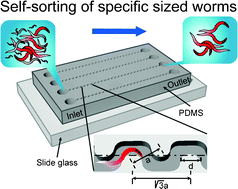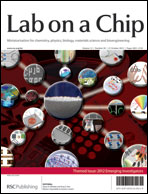A sorting strategy for C. elegans based on size-dependent motility and electrotaxis in a micro-structured channel†
Abstract
Caenorhabditis elegans (C. elegans) is a model organism widely utilized in various fundamental studies in developmental, neural and behavioural biology. The worm features four distinct larval stages, and many research questions are stage-specific; therefore, it is necessary to sort worms by their developmental stages, which are typically represented by different size ranges. However, manually synchronizing large populations of worms is time-consuming and labour-intensive, and the commercially available automated sorter is massive and expensive. Realizing the need for a cost-effective and simple micro-platform for sorting, we report an inexpensive and novel method to accomplish this goal. The proposed micro-platform features hexagonally arrayed microstructures with geometric dimensions optimized for the maximum motility of the worms based on their sizes. In each of the optimized micro-structured platforms, only the worms with the targeted size swim continuously with the maximum undulation frequency. Additionally, the persistent and directed movement of the worms can be achieved by applying an electric field along the channel. Based on the optimally spaced microstructures and the electrotaxis behaviour of the worms, we demonstrate the feasibility of a sorting strategy of C. elegans based on their size-dependent swimming behaviour. This micro-platform can also be used for other applications, such as behavioural studies of normal and locomotion-defective mutant worms in complex structures.


 Please wait while we load your content...
Please wait while we load your content...